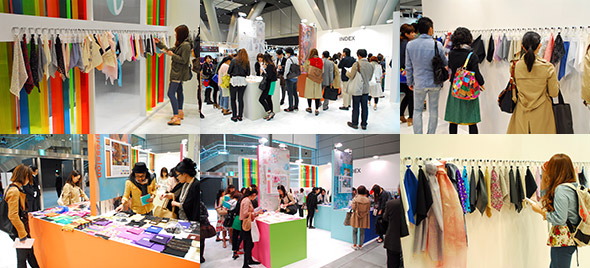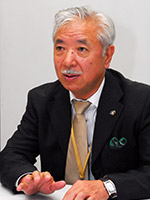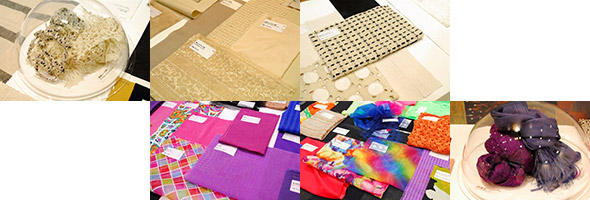![INDEX[1]Premium Textile Japan 2014 Spring/Summer Post show report - Part 2 -](images/title_index_01.gif) |
This is the Part 2 of our post-show report of the PTJ 2014 SS fair, held on May 8-9 at the Tokyo International Forum. |
| |
・Businesss matching programme
・Individual consultation on exporting for the PTJ exhibitors |
| |
・Exhibitors’ feedback - Recursion to domestic production / Hope for export
・Visitors’ feedback - Closer contacts and exchanges required for better creation |
The <Premium Textile Japan (PTJ) 2014 Spring/Summer> fair, organised by the Japan Fashion Week Organization (JFW), was held on May 8-9 and ended successfully. Many visitors came to the 2-day fair, while additional events at the venue included a business matching programme alongside an individual export consultation session for PTJ exhibitors to support future textile exports. |
| < Dates > |
May. 8 - 9, 2013 (Wed.-Thu.) |
| < Venue > |
Tokyo International Forum, Exhibition Hall 2 |
| < Organiser > |
Japan Fashion Week Organization |
| < No. of exhibitors > |
67 companies /85.5 standard booths |
| |
(incl. overseas exhibitors: 7 companies /8 booths) |
| < No. of visitors > |
5,124 (Total) |
|

‘Intense dialogue boosts efficiency’
- Business matching programme - |
A business matching programme, a perennial and acclaimed key event, was also included in the PTJ fair. Participants from 23 exhibitors met with VIP buyers in 37 set-ups. The VIP buyers from apparel companies/retailers included ABAHOUSE INTERNATIONAL Co., Ito-Yokado Co., Ltd. <Made in Japan > Project Team and Takashimaya Co., Ltd. (Crossmedia Business/Catalogue Sales Div.), while designer maisons included <ayumi.mitsukane > (Ayumi Mitsukane), <DRESSCAMP > (Toshikazu Iwaya), <HAN AHN SOON > (Hanahn Soon), <HISUI > (Hiroko Ito) – a total of 7 companies. This is an exclusive programme at our PTJ fair, providing occasions for both parties (makers & buyers) in separate individual meeting spaces where they can sit and engage in clearly focused business talks freely and calmly. This gives exhibitors /suppliers the time to showcase their fabrics with detailed explanations while buyers are free to ask several questions. |
*Takashimaya Co., Ltd.
Crossmedia Business / Catalogue Sales Div. Development Group No. 1
Ms. Michiyo Suzuki, Deputr (Photo/y ManageLeft)
Mr. Fuminori Nagai, Section Manager (Photo/Right) |
|
Although this was our second time to participate in this matching programme, time was not quite sufficient. When we hear the stories behind the fabric manufacturing from the makers, we discover a surprisingly large number of keenly sought-after fabrics with strong attachment. Last year, we featured one of the companies introduced through this matching programme in our catalogue entitled ‘Power of Japan’ (Japan skills), including photos of their factories. This time we met three different companies in this programme, who showed off new fabrics with interest.
Department stores tend not to purchase fabrics – this is done by apparel companies to make products. Consequently we create products by collaborating with apparel companies, fabric suppliers and ourselves - 3 parties coming together. Although the PTJ fair participants are limited to textile makers, we hope to also persuade sewing companies to participate, as we believe this would strengthen the ‘Made in Japan’ creation by teaming up as a single entity when textile / sewing / apparel / retailing all go hand in hand. |
*<DRESSCAMP >
Designer Toshikazu Iwaya |
|
I once participated in the Japan Creation fair (organised by JFW) when I used to handle fabrics. The good thing about the PTJ business matching is that we can pre-check the fabrics of makers of interest, prior to on-site negotiation, which helps us have clearly focused business talks. It is also more efficient and business-like to arrange face-to-face individual meetings rather than visiting the exhibitors’ booths one by one, as we can concentrate on discussing the key points in a focused way.
When I do go around PTJ booths, it is obvious what each exhibitor intends to target or promote or the direction in which they want to go and whether they are showcasing items out of a particular creation. Although I never purchase fabrics which do not coincide with my own direction, even if they are specially made, I still find them more appealing than makers who try to cover everything with a wide range. Japan-made fabrics are often considered expensive, but I do not consider the level shocking, and indeed tend to find European fabrics costlier. The ratio of Japan textiles used in my creation is about 80%, and I stick to a basis of originality. That is why I try to maintain closer relationships with fabric makers to engage in thorough dialogue and thus expand the creative potential. |
*ayumi.mitsukane
Designer, Ayumi Mitsukane |
|
This business matching programme provides an exclusively arranged individual meeting venue for negotiations, which allows participants to discuss business comprehensively and calmly, in a forum where several questions can be quite freely asked from the fabric makers. I find this system quite efficient as a regular PTJ fair visitor, since the top makers’ booths tend to be packed, making it difficult to source the fabrics I want calmly. This matching programme made it possible for me to obtain some new and unique facts and information for the first time. This time I met with 4 companies, all of whom were friendly. As I prioritise silhouettes, the ability to obtain silhouetting is key when selecting fabrics. This time, my topic of choice is the <Optical Artistic> theme. For example, an outfit seemingly separated into dual top and bottom garments is actually just a single item. Sharing this concept would allow me to source suitable fabrics for my creation. |

‘It was extremely useful and helpful.’
- Individual consultation on exporting for PTJ exhibitors - |
The Japan External Trade Organisation (JETRO) implemented an advisory programme on overseas sales channels and expansion of exporting for small- and medium-sized enterprises exhibiting in the PTJ fair. Efficient presentation/proposals with sufficient acknowledgement and understanding of overseas buyers becomes key during negotiations, alongside follow-ups which would affect business achievement. This programme was established to support those attempting to tackle overseas business and needing basic know-how or those experiencing difficulties despite all efforts involved. Mr. Kazuyoshi Muto, Coordinator of JETRO, who has considerable experience in exporting overseas to Europe/USA engaged in individual consultations, providing concrete advice on-site and also checking exhibitors’ fabrics, coping on a case-by-case basis.
One of the participants, TATSUMI WEAVING CO., LTD. commented ‘It was extremely useful and helpful. Since we have no agent in the USA, Mr. Muto will introduce someone. We also learned how to follow up our business after sending out our fabric swatches for the very first time.’ which seemed quite satisfactory.
FURUHASHI WEAVING CO., LTD. also praised this advisory programme with these words:‘It was truly useful in concrete terms, particularly the examples of how to handle agents; not only when we receive orders but to require a monthly report. We were also told about particular finishing for exporting items and the fact that overseas markets prefer neat and pretty fabrics, even using the same base as grey fabrics. We would like to take the opportunity presented by the present weak yen market.’ |

| *Feel free to engage in consultation - Coordinator, Mr. Kazuyoshi Muto - |
 |
I visited a total of 17 companies to give on-site advice over two days, covering various types of business; those with previous exporting experience, those aiming to newly challenge exporting from now and so on. I had the strong impression quite a few companies suffer from efforts to break out of their shells. In case the roadblock means breaking the target of a hundred million JPY or 1 billion JPY, the human resources/capability of employees may be key, while if the target rises to the 3 - 5 billion JPY scale, internal company restructuring may be involved. The level of 5 - 10 billion JPY would certainly require an overseas organisation such as a trading company to be established etc.. When I checked the fabrics in their booths, I was also asked concrete questions like ‘What is the appropriate selling price or price range?’, or ‘When should we start selling?’, and other questions including ‘What is an agent? How do we process contracts with agents?’ What I can tell is that the exporting business happens to require long-term negotiation. Accordingly, I simply hope this consultation programme can help contribute to the initial step. I advised those I consulted to feel free to approach me for any further advice whenever they had difficulties or were in trouble, even after the PTJ fair is over. I truly wish to further support the exporting business of Japan textiles by optimally exploiting experienced experts, including retired OBs. |

|
![INDEX[2] Upcoming schedule for fiscal year 2013](images/title_index_02.gif)
|
Intertextile Shanghai Apparel Fabrics
Japan Pavilion 2013 |
| < Dates > |
: |
Oct. 21 - 24, 2013 (Won.-Thu.) |
| < Venue > |
: |
Shanghai New International Expo Center |
| Premium Textile Japan 2014 Autumn/Winter |
| < Dates > |
: |
Nov. 20 - 21, 2013 (Wed.-Thu.) |
| < Venue > |
: |
Tokyo International Forum, Exhibition Hall 2 |
| < Dates > |
: |
Nov. 20 - 21, 2013 (Wed.-Thu.) |
| < Venue > |
: |
Tokyo International Forum, Exhibition Hall 1 |
|
|
|
|
|
This e-mail magazine is sent to all individuals having visited our show, JFW-Japan Creation in the past and/or who have registered for an e-mail magazine subscription on the website as well as to all members concerned.
Please refrain from replying to this e-mail address as it is used for delivering messages only.
If you would like to modify your address or unsubscribe, please contact the following: |
|
 |
|

